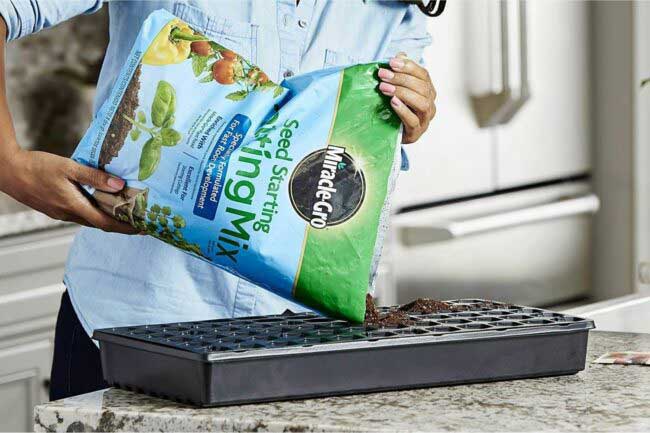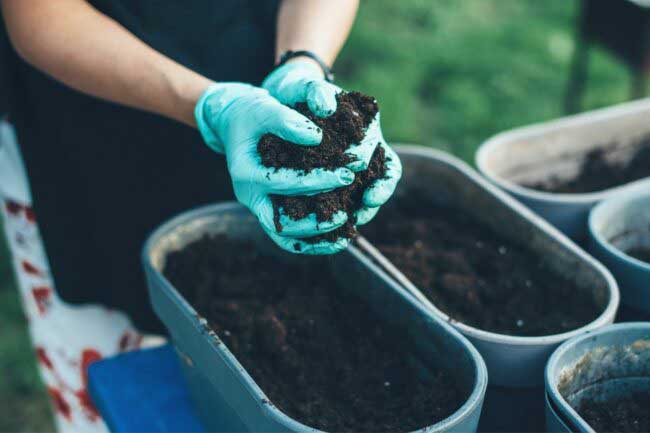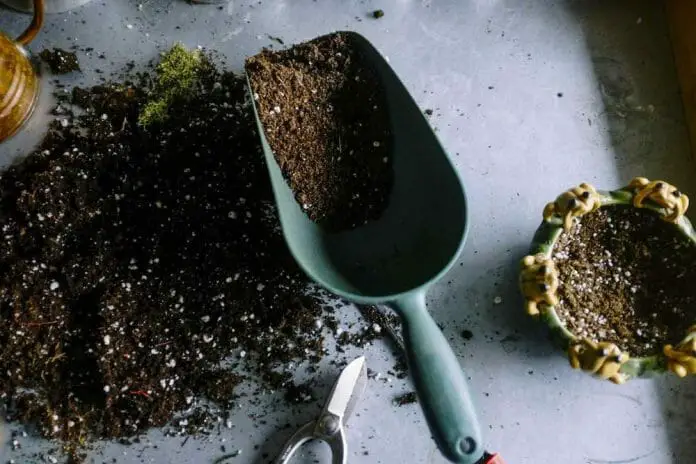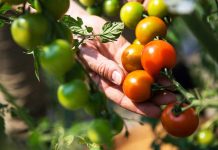Unlike soil amendments that mix into natural soil for gardening, potting soil is an all-in-one mixture for container plantings that contains everything potted plants need to thrive. It’s an essential ingredient for indoor and outdoor container gardening with two major roles: to store and release water and nutrients that plants use; and to provide a stable base for plants to structurally anchor themselves.
As an anchoring system, the soil must have a porous structure that allows the roots to penetrate deeply. As a moisture reservoir, it balances water-holding capacity and drainage, so the roots remain damp but not soggy.
Potting soil (also called “potting mix”) ingredients are similar among all types and brands, but not all potting soils are the same. Companies formulate specific ingredient proportions for different growing conditions and plant types.
Additives like fertilizer make big differences in overall performance. All this variety among products can make shopping for quality potting soil a bit of a challenge.
1. Types of Potting Soil

Plants in pots must have soil prepared specifically for container growing and for the environment in which the plants live. Outdoor containers are subject to hot sun, wind, and sudden rains that disrupt an ideal watering schedule, which means the soil used in outdoor containers should provide superior absorbency and aeration.
Indoor containers are subject to moderate temperature, little or no direct sunlight, and water from the gardener’s hand only. For these containers, choose potting mixes that provide moisture consistency and resist degradation to avoid frequent repotting.
A few plant groups grow naturally in difficult environments; in fact, they actually suffer in “ideal” growing conditions. To thrive, plants like cacti and orchids need completely different growing media. Next, this guide dives into the different types of potting soils, which is best suited for specific requirements, and what to look for in each category.
All-Purpose
All-purpose potting soils are blended to provide a balance of moisture retention along with drainage of excess water for potted plants and container gardens. They are suitable to use indoors or outdoors.
These soil blends are good for gardeners who place their potted plants in a variety of settings but prefer to buy only one product. While this type of soil can be used to grow a wide range of plants in various container types, all-purpose potting soils can dry out more quickly outdoors or retain too much water for certain houseplants.
All-purpose potting mixes often contain a conventional fertilizer that’s released as you water the plant. Many all-purpose soils are sterilized (heat-treated) to eliminate all living organisms, including weed seeds, insects, and plant diseases.
Once opened, you should use the entire contents of a bag of sterile potting mix, or close and store it securely to maintain the benefits of its sterilization and moisture-retention qualities.
Organic Mix
Organic potting soil serves the same role as all-purpose soil, but it contains all organic ingredients. It’s especially popular for use in vegetable and herb gardening.
In organic potting soil, the plant food portion is broken down biologically by soil microbes, which often are added to the mix to feed the plants, instead of dissolving in water.
Rather than sterilization, organic soil mixes are processed by composting. Composting reaches a high enough temperature to kill diseases, weed seeds, and insects, but it allows the beneficial fungi and bacteria to survive.
Seed Starting Mix
Seed starting mix is designed to sprout seeds for plants that gardeners transplant to a permanent home in the ground or a container. Gardeners typically use it in multicell trays in a highly controlled environment. Seed starting mix usually contains sterile, finely textured peat moss and perlite.
Sometimes, seed starting mixes contain no fertilizer because they’re intended for short-term use only—no longer than a month—during which time the young seedlings receive nourishment from the nutrients inside their seed coating. When the seedling must remain in the trays a bit longer, growers often add liquid fertilizer to help them thrive.
Outdoor Mix
Outdoor potting mix is heavier and coarser than indoor mix. In addition to retaining moisture in the hot sun, it must anchor plants to withstand strong winds. Outdoor potting mix has long fibers and a large particle size, which helps reduce the surface area and increases its water-holding capacity as it resists compaction.
The open soil structure allows water to travel efficiently through the soil pores, where it’s either absorbed by the large particles or drains away freely. On hot, sunny, and dry days, the chunky soil particles gradually release their moisture, which helps keep the plants hydrated.
Plant-Specific Mix
While regular potting soil works well for most plants, a few plant types have adapted to very different growing conditions; as a result, they need potting soil with unique characteristics to help them thrive.
Cacti and succulents prefer a mix that dries out quickly without compacting or shrinking away from the pot. Cactus mix, which often has a gravelly or sandy texture, usually contains a bit of organic matter to retain some moisture and nutrients.
Certain orchids and bromeliads are epiphytic plants; in their natural habitat, they grow among the tree canopies in humid climates with no contact with soil. These plants perform well when potted in coarse bark or a mixture of bark, perlite, and peat moss.
2. What to Consider When Choosing the Best Potting Soil

Potting soil is a “soilless” mix, which means it contains no natural soil like that in your garden or on the forest floor. Instead, manufacturers blend organic and mineral ingredients, as well as other ingredients, such as wetting agents and fertilizer, to create the mix.
As noted earlier, different soil blends perform well under different circumstances. When choosing the best potting soil, consider the type of plant and its fertilization needs as well as the potting soil’s ingredients and texture.
Plant Type
Many plants can thrive in most potting soils, so an all-purpose soil is a good choice for general use with houseplants and outdoor potted plants. However, if you’re growing edible herbs, veggies, and fruits, you may prefer an organic potting soil to help keep your entire growing environment system “all-natural.”
Cacti and succulent plants need fast-draining soil with just a bit of organic matter, so you’ll want to find a specialty cactus mix for these plants. Many orchids and bromeliads dislike “wet feet,” but they still need a humid environment. Again, choose soil mixed specifically for orchids for the best growing conditions.
Ingredients
Peat moss and perlite are the most common ingredients in potting soils. Peat moss is the dead moss and other organic material that collects at the bottom of peat bogs, where it builds up in deep layers for hundreds of years before it’s harvested. It’s highly absorbent and naturally resistant to decay.
Perlite is a volcanic rock that’s mined, crushed, and super-heated, which makes it expand like popcorn to 20 times its original size. Perlite has an open structure that allows water and air to circulate freely, which helps promote drainage in the potting mix.
The bark is a byproduct of lumber milling that acts similarly to perlite. Composted forest products include sawdust, wood shavings, and decayed bark. These natural products add weight and density in addition to helping the soil retain moisture, all characteristics that are helpful when growing plants in outdoor containers and raised garden beds.
Instead of peat moss, some manufacturers use coco coir, which is a material extracted from coconut shells and processed into a moisture-retentive fiber less acidic than peat moss.
Nutrients
Vendors list potting soil nutrients on the product label as a ratio of percentages (based on total package weight) in the order of their nitrogen-phosphorus-potassium (N-P-K) content. Nutrients can be of either conventional chemical origin or organic.
Conventional nutrients are chemical formulations, such as ammonium nitrate and potassium sulfate, that dissolve with heat and moisture and are absorbed directly by the plant’s roots. These formulations are especially popular for houseplants or in conditions in which the grower doesn’t want to have fungal growth or other microorganisms present.
Organic nutrients come from composted manure, agricultural waste products, and other natural sources. Before the plant roots take up the materials, they are broken down by bacteria and fungi. These products are popular with gardeners who want to replicate the natural way that plants receive nourishment in the wild.
The nutrients supplied by potting soil last from a few weeks to a few months, but they eventually will run out. Over the long term, potted plants require additional fertilization. You can add granular or liquid fertilizer to the soil.
Aeration
Soil aeration allows plant roots and water to penetrate through the mix, and it promotes healthy gas exchange between plant roots and the atmosphere. Varied particle sizes and decay-resistant ingredients help maintain good aeration in your potting soil.
High-quality peat moss is composed of a mixture of large and small particles, and it’s naturally resistant to decay. As minerals, perlite and vermiculite don’t decay and help provide a healthy, open soil structure.
Moisture Control
Peat moss absorbs as much as 30 times its own weight in water, while coco coir can absorb nine times its weight. These attributes make them good base materials, but your plants need a balance to ensure that excess water drains away. Perlite helps ensure that plant roots get enough moisture, but not too much.
Some potting soils include a water-holding polymer that grabs even more excess moisture and slowly releases it after the surrounding soil has dried out. These ingredients help keep plants alive outdoors in intensely dry weather.
Fungal Growth
Mold grows on all kinds of organic material, including, if the conditions are right, pH-balanced sphagnum moss in potting soil. When you first purchase a bag of sterile potting soil, it doesn’t contain fungal spores, but it can begin to harbor them any time after you open the package. Organic potting soils often include beneficial fungi and bacteria that serve as intermediaries between plants and nutrients.
White fuzzy growth on the soil surface is harmless to plants; it’s a fungus feeding on the decaying ingredients in the potting soil. Simply scrape it off if it appears.
Fertilizer Starter Charge vs. Slow Release
Don’t rely solely on your potting soil to supply all of your plant’s nutrient requirements: They eventually will need fertilizer. Potting soil fertilizer comes either in a starter charge or slow-release formula. A starter charge is a light dose of plant food to help the plant become established, but after a few weeks, it diminishes.
Slow-release fertilizer continues to feed for up to a few months, depending on the specific formulation. Read the label to know exactly when you’ll need to apply the next dose of plant food.
3. How to Use Potting Soil
Potting soil is an all-in-one growing medium, so gardeners don’t need to add other types of soil or amendments to improve it. To report a plant: Place a small amount of potting soil in the bottom of the new container, add the plant so the upper surface of its root ball is about ½ inch lower than the top of the pot, and firm in additional soil around the root ball until the soil is level with the root ball surface. Water thoroughly to eliminate air pockets, and it’s good to go.
Potting soil comes in different-size bags, typically in quarts or cubic feet. Common sizes are 4, 8, and 16 quarts, as well as 0.5, 1.0, and 1.5 cubic feet. For the sake of comparison, there are approximately 30 quarts in a cubic foot. Below is a list of standard pot sizes and the amount of potting soil it takes to fill each size. The measurements reflect the pot diameter inside the rim. Since pot volume changes with shape, consider this a guideline only.
- 4-inch pots use about 0.5 quart of soil.
- 6-inch pots use approximately 1 quart of soil.
- 8-inch pots use about 3 quarts of soil.
- 10-inch pots use around 5 quarts of soil.
- 12-inch pots use approximately 12 quarts of soil.
- 14-inch pots use about 18 quarts of soil.
4. FAQs About Your New Potting Soil
For best results, be sure to choose a potting soil suitable to your garden collection. Read on to learn more about choosing the best potting soil.
Q. Which is better: potting soil or a potting mix?
Potting soil and potting mix are two names for the same type of product. Also, watch for the terms “container soil” and “container mix.” All four of these products are “potting soil.” Avoid buying a product labeled “topsoil” or “gardening soil” for container plants without first checking the label. These products are intended for in-ground use.
Q. Which kind of soil is best for growing plants?
Plants need consistent moisture, good aeration, a steady nutrient supply, and a solid anchoring system. Potting soil is the best kind of soil for growing plants in containers because it provides all these characteristics.
Q. What’s the difference between indoor and outdoor potting soil?
Indoor potting soil dries out too quickly to be used outdoors, while outdoor potting soil retains too much moisture to be used indoors. If you want to buy only one product, all-purpose potting soil is designed to work well indoors or out.
This article is taken from Bobvila.com, you can see the potting recommendations there.



